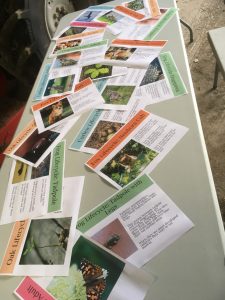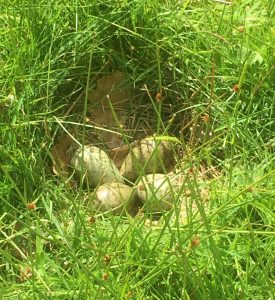Curlew Cam and Educational Programme
 As the Curlew Cam nest approached hatching time, we launched an educational programme which will continue alongside our headstarting activities enabling young people of various ages to better understand Curlews and what they need. Recently we welcomed children from Farlow School who were visiting as part of the Common Cause initiative hosted locally by Shropshire Hills AONB. Children had an introductory talk about Curlew, met our giant model, engaged in specially created games and activities and in small groups were taken to see our Curlew chicks. Curlew Cam and these activities have been sponsored by the Curlew Recovery Partnership. If you are interested in our educational engagement work for older learners please contact us at curlewcountry@gwct.org.uk. For primary school children, please click here to visit our new educational resources page.
As the Curlew Cam nest approached hatching time, we launched an educational programme which will continue alongside our headstarting activities enabling young people of various ages to better understand Curlews and what they need. Recently we welcomed children from Farlow School who were visiting as part of the Common Cause initiative hosted locally by Shropshire Hills AONB. Children had an introductory talk about Curlew, met our giant model, engaged in specially created games and activities and in small groups were taken to see our Curlew chicks. Curlew Cam and these activities have been sponsored by the Curlew Recovery Partnership. If you are interested in our educational engagement work for older learners please contact us at curlewcountry@gwct.org.uk. For primary school children, please click here to visit our new educational resources page.
Curlew Breeding season
It was a long slow dry, often warm, spring of great beauty, but not so good for Curlew trying to probe bills into wet ground to feed and get into condition for breeding. On one such enchanting spring day I drove north through a tapestry of gently coloured trees in bud to join fellow Curlew Recovery Partnership Steering Group members at Bolton Hall in Swaledale. When I returned on the evening of the following day the trees had burst into full bright leaf and it was like driving through a different country. Nesting is always, counter-intuitively, later in Curlew Country than in upland areas and was later still due to the cold dry weather. As usual it was a race against time to find eggs before they were predated. In our eighth year, natural losses still frustrate us and natural nest success is what we really want to be achieving with the research and experience of our early years.
probe bills into wet ground to feed and get into condition for breeding. On one such enchanting spring day I drove north through a tapestry of gently coloured trees in bud to join fellow Curlew Recovery Partnership Steering Group members at Bolton Hall in Swaledale. When I returned on the evening of the following day the trees had burst into full bright leaf and it was like driving through a different country. Nesting is always, counter-intuitively, later in Curlew Country than in upland areas and was later still due to the cold dry weather. As usual it was a race against time to find eggs before they were predated. In our eighth year, natural losses still frustrate us and natural nest success is what we really want to be achieving with the research and experience of our early years.
Work with farming partners
Some of our farming partners found nests again. The first farmer to find a nest filmed a short piece to describe the event and his experience of a moment that characterised our landscape in the early Spring morning for him. The second, not so far away was also found by a good nest-finder.
to describe the event and his experience of a moment that characterised our landscape in the early Spring morning for him. The second, not so far away was also found by a good nest-finder.
The dry spring and the current farming financial climate meant that there was also much late agricultural rolling, harrowing and fertilising, which no doubt will have been the cause of some lost eggs. Inevitably we have met and worked with several new farmers this year – Curlew don’t recognise boundaries. JP has been working with farmers and land managers on habitat creation and improvements for Curlew, including species rich meadow planting, re-wetting areas for Curlew foraging and creating scrapes, thanks to Severn Trent’s Boost for Biodiversity Fund.
Great team
Our new team members Katie, Jake and Rebecca seem as though they have always been here and now our local volunteer team is returning to known routines with the chicks. Our volunteer vets are being amazing at surprising hours as ever. Our landlords at both the incubation site and the chick rearing site have been as kind and as helpful as ever as have our endlessly patient office landlords. Headstarting is at its busiest. We were all delighted to see old friend of Curlew Country, aviculturalist Rosie, who has arrived to spend her holiday with us and help out.
And more..
 I have been working with Ben Osborne updating the Curlew Observation Film with funding from the Curlew Recovery Partnership. We have long wanted to update it with what we have learned over the years since 2015 and break it down into subjects. Thanks to all the people who have helped with the filming sites in particular. We have been and will be training people who have asked us for help.
I have been working with Ben Osborne updating the Curlew Observation Film with funding from the Curlew Recovery Partnership. We have long wanted to update it with what we have learned over the years since 2015 and break it down into subjects. Thanks to all the people who have helped with the filming sites in particular. We have been and will be training people who have asked us for help.
We have been answering calls for help and advice as usual, but also pointing people toward the growing resources of the Curlew Recovery Partnership. Then of course there are the usual talks, interviews, events and trying to find funding to keep our important work going.

